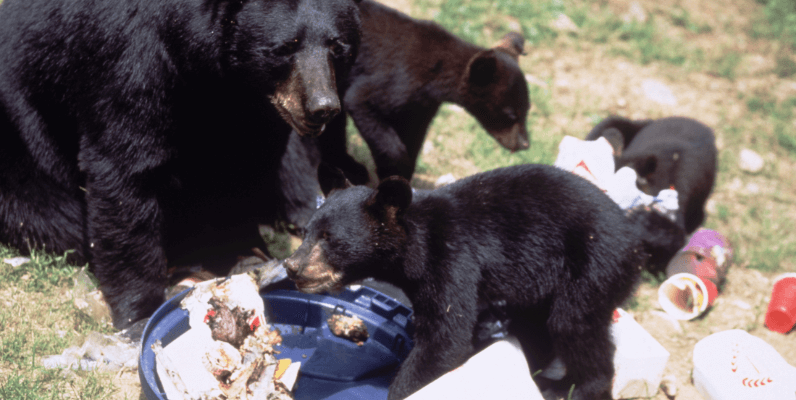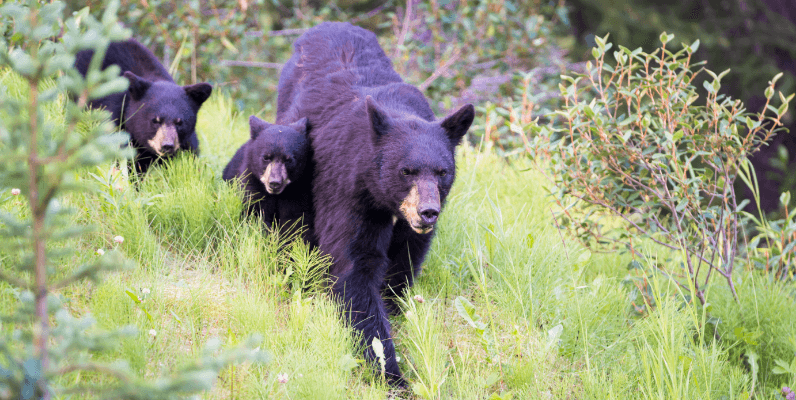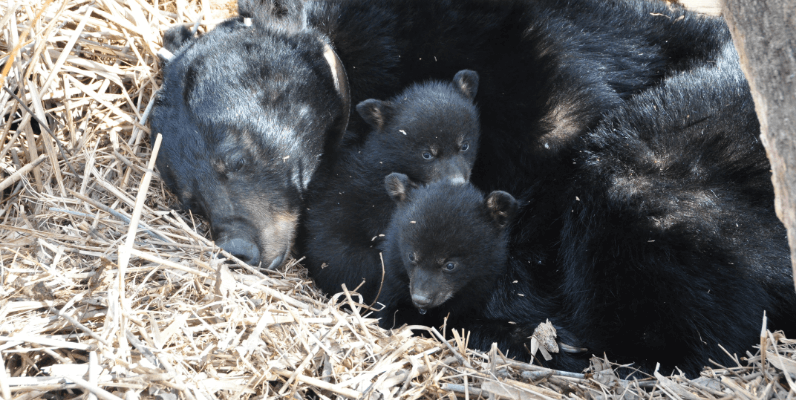Farming Practices
Black bears like a wide variety of foods including sweet corn, field corn and insects. Livestock including honey bees, chickens, rabbits, sheep and goats are also subject to depredation by black bears. The following information is offered to help farmers deter black bears if they are experiencing crop, orchard, garden, or beehive damage or livestock depredation.
NJDEP’s Fish and Wildlife recommends the following farming practices for protecting corn and grain crops, orchards, vegetable gardens and compost piles, apiaries and livestock from depredation by black bears:
- Livestock pens, beehives, vegetable gardens and compost piles should be located at least 50 yards from forest tree lines, wetlands, or other cover for bears.
- Crops, such as sweet corn, field corn or grain, should be planted as far away as possible from forest tree lines, wetlands, or other cover for bears.
- Keep areas around livestock, crops, beehives, orchards, gardens and compost piles well mowed to reduce cover for bears.
- Black bears may be repelled by installing mechanical scare devices around livestock, pastures, crops, beehives, orchards, gardens or compost piles, which activate by a motion-sensing device. Scare devices include noise-making pyrotechnics, electronic sirens, strobe lights and noise generators.
- Electric fencing is the most effective and efficient method of preventing bear damage to livestock, beehives, crops, silage bags, orchards, gardens and compost piles. Fencing is only effective if it is properly installed and maintained.

Damage Control Measures and
Farmer Depredation Permits
Depredation permits are available to eligible farmers who are experiencing crop and livestock depredation by black bears.
For more information, contact Fish and Wildlife at 1-877-WARN DEP (1-877-927-6337).

Additional Tips

Protecting Livestock
Livestock feed should not be left out overnight unless enclosed in a certified bear-resistant container (www.njfishandwildlife.com/bears/garbage-management.html). Store feed in a secure area.
Carcasses of dead animals should be properly disposed of or destroyed to prevent black bears from scavenging near susceptible livestock or crops.

Protecting Orchards
Farmers with fruit trees should recognize that bears will be attracted to any fruit left on the ground. To minimize bear activity, pick up any fruit that falls from trees daily. Discard fruit in certified bear-resistant garbage containers (www.njfishandwildlife.com/bears/garbage-management.html).
Individual trees may be protected by using proper fencing techniques, such as electric fencing, if the limbs, leaves, and fruit are at least eight feet off
the ground.

Protecting Gardens/Compost Piles
Harvest gardens immediately as vegetables mature. Keep gardens free of vegetable wastes.
Do not place meat, dairy or sweet foods in compost or mulch piles. Adding lime can reduce odors and help decomposition.

Electric Fencing Construction
Properly installed electric fencing is the most effective and efficient method of preventing bear damage to livestock, beehives, crops, silage bags, orchards, gardens and compost piles.
Fish and Wildlife’s Wildlife Control Unit is available to provide technical advice with fence construction to those interested in installing electric fencing to prevent bear damage to beehives, agriculture crops and livestock. For more information, contact Fish and Wildlife at 1-877-WARN DEP (1-877-927-6337).
Construction
Fence construction should be simple and as strong as possible. Detailed instructions on properly installing temporary or permanent electric fencing are provided in the guide Bears and Electric Fencing: A Starter’s Guide for Using Electric Fencing to Deter Bears, by Kim Annis, Montana Fish, Wildlife & Parks, Bear Management Specialist.
The following is an overview of a general method for installing an easy to erect electric fence that is effective in most cases.
- The electric fence should be placed 4 to 5 feet away from the structure that is being protected (beehives, shed, rabbit hutch, etc.). The fence and protected structure should be placed away from any trees, which a bear could climb and then drop down into the fenced-in area.
- Drive the corner posts of the fence. Use treated wooden posts and reinforce them with braces.
- Remove grass and weeds in an 18 inch strip along the fence line. Spray the cleared area with an herbicide to prevent the return of vegetation.
- Do not spray wider than 18 inches because the bear will be better grounded if it is standing on grass. Organic alternatives to using an herbicide include using mulch, wood chips or landscape fabric.
- Install the fence posts 8 feet to 12 feet along the fence line. If the fence is permanent, it is best to use all solid wooden posts and 14 Ga or 12
- Ga steel wire. If the location is not permanent, use wooden corner posts and metal line posts with 14 Ga or 12 Ga steel wire. 14 Ga aluminum wire or polywire (9+ strands) can be used for a temporary fence. Note that polytape is not effective for bear exclusion.
- Drive the ground rod made of galvanized steel at least 6 feet deep into moist soil near the post for the energizer. Use 1 ground rod per joule of energizer’s output. In very dry or rocky soils, drive the rod deeper than 6 feet or drive it at a steep angle at a shallow depth to maximize surface area. Three or more rods can also be placed in a series 10 feet apart. Frequently water dry soil around the ground rod.
- Install the insulators on posts to secure hot wire strands and install wires, starting at the gate post.
- The fence needs to be at least 4 feet high and the wires need to be spaced close enough so that cubs are discouraged from entering the fence.
- If using an All-Hot fencing system, use at least five strands of high tensile, galvanized wire at 4 inches, 16 inches, 26 inches, 36 inches and 48 inches above the ground. If using a Hot/Ground fencing system, use at least 7 strands of alternating hot and ground wires. The bottom and top wires should always be hot wires. Hot wires should be no more than 12 to 15 inches apart and wires should be spaced 6 inches apart.
- Stretch the wires to eliminate sagging. Wire strainers can be used for this. Use stones or weights to keep the wires at the correct heights when going over low areas.
- Install the energizer with a minimum joule rating of 0.7 and a voltage output of at least 6,000 volts. Energizers should be compatible with the type of wire used. Check the manufacturer’s recommendations to be sure that all the requirements are met.
- Attach extra wire to the hot terminal and hot wires. Attached a second wire to the negative terminal, ground rod(s) and ground wires (if hot/ground fence.)
- Energize all wires in the fence system. Verify with a voltage meter that sufficient current is running through each hot strand.
- When possible, use a plug-in charger rather than battery or solar power. If needed, after the initial 2 months, switch to battery or solar power. The battery should be located inside the enclosure and it should be at least a 12 volt, 70-amp hour deep cycle battery.
Baiting the Fence
- Bait the wires on the electric fence to direct a mild shock onto the muzzle area of a black bear. This makes the fence much more effective, regardless of the size of the bear.
- The fence should be baited on all sides at 3 feet high, so it is at eye/nose level for a bear.
- Bait the wires on all sides with bacon wrapped around the wire. If crows are observed taking the bacon, use peanut butter wrapped in tin foil. When a bear grabs the bait, it will get a shock to its tongue and mouth.
Maintenance
The following tips are offered to ensure proper maintenance and effectiveness of your electric fence. Every time you visit the site, and at least one a week, check the following:
- Make sure the wires are tight.
- Check voltage on all wires with a voltage meter.
- Keep wires baited at all times.
- Ensure solar-powered chargers are positioned properly and are not located in the shade.
- Change the batteries as needed. Marine battery terminals and lead composition eyelets resist corrosion.
- Remove vegetation beneath the fence that may be touching the wires and any debris, like branches, that may fall on the fence.
- USDA Electric Fencing Diagram
Additional Resources
Electric Fencing Supplies
The following resources are provided for informational purposes only; listing does not confer or imply an endorsement by Fish and Wildlife:
Electro Bear Guard
907-235-7907
info@electrobearguard.com
electrobearguard.com
Gallagher Animal Management Systems
Regional Contact: Greg Miller
800-531-5908
am.gallagher.com/en-us
Zareba
855-5-ZAREBA
www.zarebasystems.com
Additional Energizer (Unigizer) Suppliers
Stafix
https://nz.stafix.com/products/energizers/x1-unigizertm
Patriot
www.patriotchargers.com

 Official Site of The State of New Jersey
Official Site of The State of New Jersey






